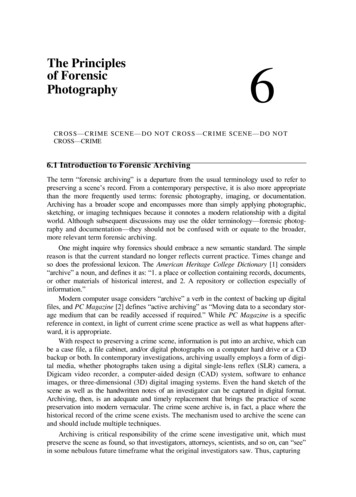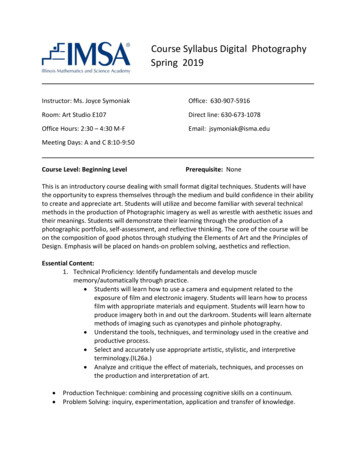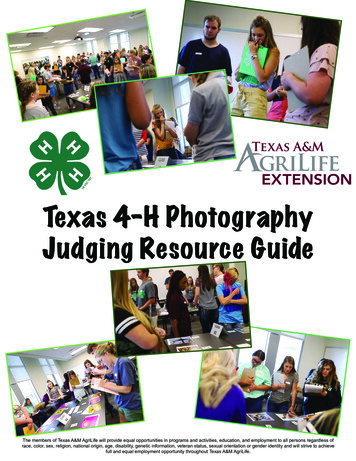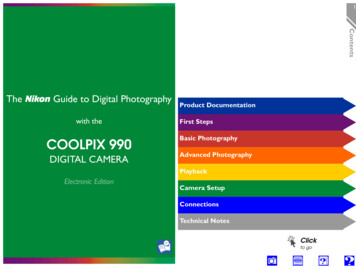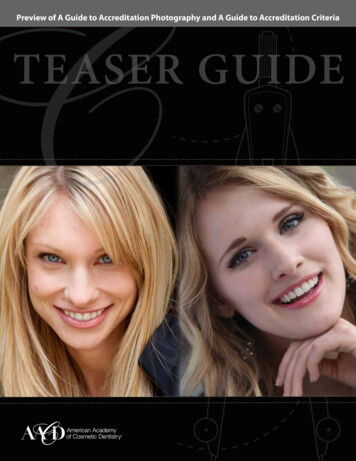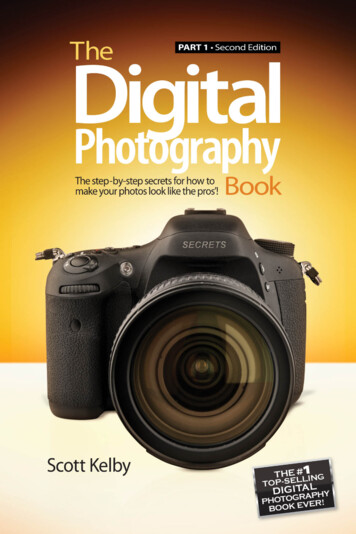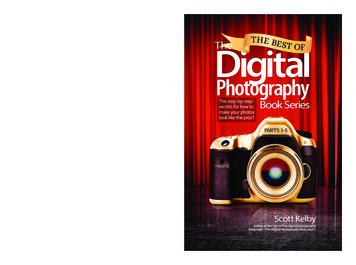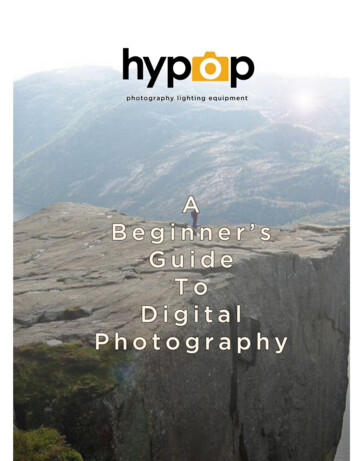
Transcription
ContentsBeginner’s Guide to Digital PhotographyIntroduction p. 1Chapter I: Fundamentals of PhotographyBrief History of Photography p. 2Introduction to Digital Photography p. 3Digital Camera p. 4dSLR p. 4Digital Rangefinder p. 5Coincident Rangefinder p. 5Digital Point and Shoot p. 6Advantages and Disadvantages of DigitalPhotographyAdvantages of Digital Photography p. 7Disadvantages of Digital Photography p. 9Chapter II: The Camera- Components andConceptsLens p. 11Focal Length p. 11Lens Types p. 12Telephoto p. 13Wide-Angle p. 14Zoom p. 14Prime p. 15Aperture p. 15F-Stop p. 16Depth of Field p. 17Shutter p. 18Shutter Speed p. 18Image Sensor p. 19CCD p. 20CMOS p. 20Memory Cards p. 21External Flash p. 21File Types p. 22RAW p. 22JPEG p. 22TIFF p. 23Chapter III: Capturing an Image, Hands-onBasicsComposition p. 24Elements of CompositionPattern p. 25Symmetry p. 26Texture p. 27Depth of Field p. 28Lines p.29Law of Thirds p. 30Camera Shake p. 31Red-Eye p. 32Lighting p. 32Under Exposure p. 32Over Exposure p. 32Digital Noise p. 34Chapter IV: Exposure ModesAutomatic Mode p. 36Manual Mode p. 36Program Mode p. 36Aperture Mode p. 36Shutter Mode p. 37Scene Mode p. 37
Portrait p. 37Landscape p. 37Close-up p. 37Sports p. 38Twilight p. 38Night Mode p. 38Black and White, Sepia p. 38Panoramic p. 38Chapter V: General Tips in Digital PhotographyLighting p. 39Importance of Natural Light p. 39Best Time of Day to Take Photos p. 40Disable Flash Indoors p. 41Disable Flash in Low Light p. 42Use Flash to Balance Bright Light p. 43Get Closer to the Subject p.44Crop Your Photo p. 45Choose Better Backgrounds p. 46Pick Proper Orientation p. 47Use Point of View p. 47Frame your Subject p. 48Experiment with Abstract Photography p.49Holding your DSLR p.50Chapter VI: Post ProductionThe Digital Workflow p.51Step 1 Capturing the Image p.52Step 2 Storing the Photo p.52Color Depth p.54Step 3 Cataloging the Image Files p.55Step 4 Editing the Photo p.56Step 5 Sharing p.57Step 6 Archiving and Backing Up the Photograph p.57Wrapping Up p.58References p.59
IntroductionIf you enjoy traditional photography and are still fairlynew to digital media, this section is for you. In this ebook youwill find basic information about the types, components, andconcepts as well as the pros and cons of using your digitalcamera.People take photos for numerous reasons. Some take pictures forscientific reason while others shoot to document the events of the world.Some take pictures for a live advertising and many do it for sheer enjoymentand artistry.This chapter covers:Brief History of Photography(p. 2)Introduction to Digital Photography(p. 3)Digital Cameras(p. 4)Advantages and Disadvantages ofDigital Photography(p. 7)
CHAPTERIBrief History of PhotographyLong before photography was discovered, artist used a cameras darkchamber or obscuras in Italian. Light would enter the chamber through asmall opening called a pinhole and the light would then project an image ofthe scene onto the opposite wall. At first, large rooms were speciallydesigned to exhibit this “magical” phenomenon; but in the 16th century,Italian artists compressed the size of the chamber to a portable box,replaced the pinhole with a lens, added a mirror to invert the image, and atranslucent glass panel to display it. They manually traced the projectedimage by hand. Henry Fox Talbot as well as others had the idea to captureand reproduce the image directly and this led to the birth of photography.Despite the drastic changes in technology over the years, the dark box andthe lens still form the foundation of modern photography.
CHAPTER IFundamentalsofPhotographyIntroduction to Digital PhotographyTraditional film photography uses a chemical process to expose andcapture images. The camera lens and body allow a prescribed amount oflight to come into contact with the film, which is basically a sheet of plasticthat has been coated with a light sensitive chemical compound. Once thefilm is sufficiently exposed to light an invisible picture is formed. When thefilm is developed, other chemicals are applied and the image then becomesperceptible forming a negative image which then can be enlarged andprinted on photographic paper.In digital photography the film is replaced with a light sensitiveelectronic device known as an image sensor. These sensors are made up ofmillions of photoelectric devices that convert light into an electrical signal.The two most common types of image sensors used in digital cameras areCCD (charge coupled device) and CMOS (complementary metal-oxidesemiconductor) sensors.The strength of the electrical signal depends upon the amount of thelight that exposes the image sensor. These electrical signals are thenprocessed through a series of complex electronic circuits and finally storedin some type of internal or external flash memory in a standard image fileformat such as a JPEG file. (JPEG Joint Photographic Experts Group). Whenprocessed by a computer, these files produce an image which is able to beprinted on photographic paper.Just as camera film is available in different sizes so are digital imagesensors. The smaller sensors found in cell phone cameras and small pointand shoot cameras generally produces lower quality images than a largersensor that would be found in a digital single lens reflex (SLR) camera.
CHAPTER IFundamentalsofPhotographyDigital CameraIn its most basic form, a digital camera is a photographic deviceconsisting of a lightproof box with a lens at one end, and a digital imagesensor at the other in place of the traditional film plane. Advances in digitalphotography are fast providing a wide spectrum of features and optionsthat can be challenging for the new digital photographer to master.There are two basic types of digital cameras: digital single-lens reflex(DSLR) and digital rangefinder.Digital Single-Lens Reflex (DSLR)This camera is named for the reflexing mirror that allows you to framethe image through the lens prior to capturing the image. As light passesthrough the DSLR camera’s lens, it falls onto a reflexing mirror and thenpasses through a prism to the viewfinder. The viewfinder image correspondsto the actual image area. When the picture is taken the mirror reflexes,moves up and out of the way, allowing the open shutter to expose thedigital image sensor, which captures the image. Most features on a DSLR areadjustable, allowing for greater control over the captured image. Most DSLRcameras also allow the use of interchangeable lenses, meaning you canswap lenses of different focal lengths on the same camera body.
CHAPTER IFundamentalsofPhotographyDigital RangefinderThere are two classes of digital rangefinder cameras: coincidentrangefinder and point-and-shoot.Coincident RangefinderUnlike DLSR cameras, the coincident rangefinder does not offer thephotographer with the capability to view the subject through the lens.Instead, the coincident rangefinder employs a mirror or prism that usestriangulation to join the images seen through the viewfinder and asecondary window to bring the subject into focus. The photographer seestwo images; one on top of the other in the viewfinder. The image is not infocus until there is a single image. When using the DSLRs, most features in acoincident rangefinder are changeable. This allows for maximum controlover the captured image. An advantage of using a coincident rangefinderover a DSLR is that the absence of a rotating, or reflexing, mirrorsignificantly reduces camera shake. Camera shake is due to unstable handmovement or the vibration of the rotating mirror found in a DSLR, and cancause blurring of the image.
Digital Point-and-ShootCHAPTER IFundamentalsofPhotographyThis is a lightweight digital camera, appropriately named after the twosteps required for the photographer to capture an image. Basically, pointand-shoot cameras require pointing the camera and taking the picturewithout manually adjusting settings such as the aperture, shutter speed,focus, and other settings that professional photographers usually set onmore sophisticated cameras. Of course, some point-and-shoot digitalcameras do include flexible aperture and shutter settings. Point-and-shootdigital cameras are normally light and small, have built-in automatic flash,require no adjusting of focus, and most often include an LCD display thatallows you to view the image through the lens in real time via the digitalimage sensor. Most manufacturers of point-and-shoot cameras separate theviewfinder from the lens assembly to simplify the mechanism and achieve acompact size. The lens, aperture, and shutter are one assembly,permanently fixed from the camera itself.Because rangefinder cameras separate the optical path between theviewfinder and the lens assembly, optical compression and frame indicators(guidelines) are used to approximate the image’s frame. This approximationoften causes subtle differences between what the photographer sees in theviewfinder and what is captured in the image. This is especially noticeablewhen the subject is close to the camera.
Advantages and Disadvantages of Digital PhotographyCHAPTER IFundamentalsofPhotographyWhy precisely are digital cameras so popular today? Is there some sortof rocket science involved, which makes digital cameras superior over rollfilm cameras? Are they really a “good thing” to all enthusiast or they dohave some drawbacks too? Let us look at some of the advantages anddisadvantages of digital cameras with respect to photography.Advantages of Digital PhotographyFirst, the good news- There are several advantages of digitalphotography and they are appropriate to everyone from amateurphotographers to professional photographers. Here's why: Eliminates Film and Film Processing- This is probably the mostsignificant of all its advantages. You do not have to spend your time andenergy in developing the roll of film in a dark room. Using a digital camera,means that you can take pictures without paying for film or wonderingwhich type of film to buy, in fact, you will never have to buy film again. Large Photo Storage- Digital cameras can easily store up to 10,000photos, depending on the size of the memory card and the quality ofpictures you are taking. This completely outweighs the storage capacity oftraditional roll film cameras. Operating Speed- In case of earlier cameras, one always had to“wind” the film after clicking a photograph. This led to a certain amount of
time delay and inconvenience to the user. With digital cameras, no suchactivity is required. You simply point and shoot.CHAPTER IFundamentalsofPhotography Face Detection- High-end digital cameras have been thoroughlydesigned for face detection through the camera lens. Minimizing theinstances of getting all those blurry faces and red-eye photographs! Motion Detection- These days, high-end digital cameras alsocome equipped with inbuilt motion detection features which adjust movingimages and thus, avoiding blurriness. This becomes particularly helpfulwhen taking pictures of moving objects; like a car race or a soccer game inprogress. Night Modes- Taking pictures in dark or dim-lit surroundings hasbecome much easier, thanks to special night mode features that are usuallyavailable in today's digital cameras. Easy Image Editing- Digital images can be edited with ease. Imageediting software are easily and widely available and they allow you to tweakthe photograph as per your preference. Viewfinder and Preview Screens- Digital cameras have viewingscreens on the camera body which allow you to view the image as soon asyou have clicked it. If you do not like it, you can simply delete it giving youback the storage space intended for better shots. Video Recording Capability- Today, most digital cameras comefully equipped with built-in video recording features. So if you come acrosssomething that you would prefer to record rather than to click, you cansimply do it using the same camera. Get Green- It is environmentally sound. No processing chemicalsto wash down sewers. The massive amount of water and electricity used toprocess film are no longer needed. Also, you won't need to worry aboutrecycling those little plastic film containers. Wiser Choice- Digital cameras are extremely cost-effective,adaptable, and offer total VFM (value for money). Besides, they are
continuously being upgraded with new features, thanks to constanttechnological advances.Disadvantages of Digital PhotographyCHAPTER IFundamentalsofPhotographyNow, the bad news- There are some downsides to digitalphotography. It is not yet perfect and we are all still paying for themanufacturers' research and development costs. Here are some of the cons: Memory Card Problems- All the photographs, video clips, etc., arestored on a memory card. In certain rare cases, the memory card canbecome corrupt or can develop other issues which can result in permanentloss of data. Higher Initial Cost- High-end, fully-loaded digital cameras tend tobe a little bit pricey as compared to roll film cameras. Battery Consumption- Battery consumption depletes morequickly in digital cameras. This makes it necessary to keep a few extrabatteries in hand, especially during extensive photo sessions. Image Resolution- 35mm film has an image resolution that isroughly equivalent to a 25 megapixel full frame sensor. While digital imagesensors continue to improve and digital cameras get better every day ingeneral, film images still wins when it comes to resolution and quality. Range- Film has a higher superior dynamic range than digitalcameras. This means that film can capture a wider range of tonal quality.This is a huge factor in overall image quality because it means it is harder tooverexpose an image using film. Film typically can produce different shadesof white which helps prevent overexposure of highlights. This means thatfilm has the advantage when it comes to capturing shades of light especiallyat sunrise or sunset. Shutter lag- Digital cameras, especially the less expensive modelsare prone to have shutter lag which is the delay in time from when youpress the shutter button and the time the image is captured.
Multiple Exposures- It is difficult if not impossible to do double ormultiple exposures on a digital camera. Plus digital cameras are more proneto noise on really long exposures.CHAPTERThe Camera - Components and ConceptsIIIn this chapter you will find the basic components of a Digital SLR Camera. Lens (p. 11)Aperture (p. 15)Shutter (p. 18)Digital image sensor (p. 19)Memory cards (p. 24), External flash (p. 21)
CHAPTER IILensThe CameraComponentsandConceptsThe lens is a sequence of complicated elements mostly made of glass, builtto deflect and focus the light from the subject to the image sensor of adigital camera.Aside from composing the image through your viewfinder, the first contactyou have with the light from your subject is through the lens of yourcamera.Focal LengthThis is defined as thedistance of the image sensor fromthe camera lens that convergeslight. This distance determines themagnification capability of the lenswhen focusing on a scene. Thelonger the focal length your
camera has, the more it can magnify the subject.Lens TypesThere are several kinds of lensesavailable to the market but the mostbasic of these lenses are Telephoto,Wide Angle, Zoom and Prime. Theyperform the same basic function of thelens: to reflect light from the subject andprojects it to the image sensor of thecamera or the film. The differenceamong them is the way they transmitand refract light to the image sensor.
CHAPTER IITelephoto LensThe CameraComponentsandConceptsTelephoto lenses are used to significantly magnify a subject at greatdistances. A telephoto lens has a long focal distance, meaning that objectscloser to the camera will appear slightly out of focus but objects at longrange will be clear and precise.Typically used by photographers with an interest in sports, nature andlandscapes, telephoto lenses allow the photographer to get the shot theywant without having to be anywhere near the “action”. Although the area ofcoverage is limited with a telephoto lens, it allows photographers to “zoomin” on the subject they desire.Higher aperture settings allow the photographer to “zoom” into thebackground, middle regions and even the foreground, allowing for thesharper image shot they really want. However, using a smaller apertureallows the photographer to combine the three focal lengths to provide aphotograph with a more “human eye” quality, combining in sharp contrast,all areas leading up to the main object.
CHAPTER IIThe CameraComponentsandConceptsWide-AngleWide-angle lenses use only ashortfocallengthallowingphotographers to concentrate theshot on the main subject but whilestill get the surrounding area infocus as well. The image plane islarger than the focal length withtraditional wide-angle lenses, but modern digital cameras have changed thatnotion. Lens multiplying factors provided by image sensors on modernDSLRs vary, so you should check the specifications on your camera. Forinstance, if your camera carries a 28mm sensor you will need a lens with afocal length of 28mm or less if you truly want that “wide-angle’ shot tocome out right.ZoomA zoom lens is the type of lenswhich possesses the mechanical abilityto alter its focal length. It is also knownas an optical zoom lens. Zoom lensescan provide variable focal lengths to thephotographer, making it a productiveprofessional tool. It can alter its focallength from wide angle to standard andfrom there to zoom. The zoom lensesare helpful for the photographers asthey do not need to hold and alter multiple lenses while working on aproject or shooting. The zoom lenses always need extra glass elements toprecisely focus light at variable focal lengths. The manufacturers must keepin mind that to achieve an image of best quality, light should pass throughthe least number of glass elements. It should also be noted that the f-stopsmight not always be absolutely precise due to the movement between thefocal lengths. To encounter this, a lot of manufacturers provide several
CHAPTER IIThe CameraComponentsandConceptsminimum aperture values when the lens moves from shorter to longer focallengths. This certainly helps to attain a higher level of precision withapertures as it makes a lens slower at longer focal lengths.PrimeThe focal length of a prime lens isunalterable. It is also termed as a fixed lens dueto this characteristic. Prime lenses are generallymanufactured with wider maximum aperturesand the lens speed is faster as a result of that. Indarker conditions, wider apertures really come inhandy as they can provide brighter pictures.Besides, one possesses more control over the depth of field while he/she isusing the wider apertures. Portrait photographers are the main users of theprime lenses.ApertureThe opening in the lens that permits light to pass through is calledaperture. The aperture is the opening formed by a system of metal leaves inthe lens that open up and close down to control the volume of light passingthrough the lens. It is the lens's equivalent of the iris of our eye. Thecombination of the opening of aperture and the shutter speed determinesthe exposure of the image or photo. More light will pass through the lenswith higher or wider aperture, which is measured by f-stops, and each f-stoprepresent the amount of light admitted from the lens.
CHAPTER IIThe CameraComponentsandConceptsIf we look on a camera specification it says:Lens: 35-105mm f-3.5-f8The "f-3.5-f8" is called the F-stop or the maximum aperture of thelens. This figure is derived from dividing the focal length of the lens by theaperture opening of the lens.A larger aperture size is represented with smaller number hence f2.8is larger f-stop than f5.6. The standardized F-stop number runs as follows:f1.4, f2, f2.8, f4, f5.6, f8, f11, f16, f22, f32, f45, f64.Each number admits half the light to the previous F-stop.
CHAPTER IIDepth of FieldThe CameraComponentsandConceptsDepth of Field (DoF) is the distance between the nearest and farthestobjects that appear in acceptably sharp focus in a photograph and isdetermined by a combination of the opening of the aperture and the focallength of the lens. A small aperture setting results in greater depth of field.Controlling depth of field is one of the earliest ways of a photographerto compose an image. By limiting the depth of field of the subject, thephotographer can turn the attention of the viewer on the subject in focus.Usually, restraining the depth of field of an image helps eliminate confusionin the background. Conversely, when shooting a landscape, you would likethe image to have greater depth of field. Limiting the depth of field to theforeground would not make viable sense to a landscape or panoramicimage.
CHAPTER IIThe CameraComponentsandConceptsTelephoto lenses (with long focal lengths) tend to have shallow focuswhen the aperture is opened all the way, limiting the depth of field of animage. Wide-angle lenses (with short focal lengths) tend to create imageswith great depth of field regardless of the aperture setting.ShutterThe shutter is a device that allows light to pass for a determinedperiod of time, for the purpose of exposing photographic film or a lightsensitive electronic sensor to light to capture a permanent image of a scene.Shutter SpeedShutter speed refers to the length of time the shutter is open or theactivation of the digital image sensor. The exposure of the photo isproduced entirely by the combination of shutter speed and the aperture.Shutter speeds are shown as fractions of a second, such as 1/8 or 1/250.Shutter speed increments are comparable to aperture settings, as eachincremental setting either halves or doubles the time of the previous setup.For example, 1/60 of a second is half as much exposure time as 1/30 of asecond, and about twice as much as 1/125 of a second.Photographers often use shutter speed settings to convey or freeze amotion. A moving subject, such as fast moving vehicle, tends to blur whencaptured with a slow shutter speed like 1/8. On the other hand, a fastshutter speed, such as 1/1000, appears to freeze the movements of fallingrain or snow.
CHAPTER IIThe CameraComponentsandConceptsImage SensorsThere are two kinds of digital image sensors generally used: acharge-coupled device (CCD) and a complementary metal oxidesemiconductor (CMOS).Figure on left basically shows the method of digitizing the image or photo. Figure on right are examplesof Digital Image Sensors found on Digital Cameras.Bayer Pattern. A Bayer filter mosaic is a color filter array (CFA) forarranging RGB color filters on a square grid of photo-sensors. Its particulararrangement of color filters is used in most single-chip digital imagesensors used in digital cameras, camcorders, and scanners to create acolor image. The filter pattern is 50% green, 25% red and 25% blue, henceis also called RGBG, GRGB, or RGGB. It is named after its inventor, Bryce E.Bayer of Eastman Kodak.
CHAPTER IICharged-Coupled Device - CCDThe CameraComponentsandConceptsCCD sensors were initially developed for video cameras. CCD sensorsrecord the image pixel by pixel and row by row. The voltage informationfrom each element in the row is passed on prior to descending to the nextrow and only one row is active at a time. It does not convert the voltageinformation into digital but to accomplish the feat, another circuitry isadded to the camera to digitize the voltage information prior totransferring the data to the storage medium like SD Cards.Complementary Metal Oxide Semiconductor - CMOSCMOS sensors are capable of recording the entire image provided bythe light-sensitive elements in parallel all at once, resulting in a higher rateof data transfer to the storage medium. Additional circuitry is added toeach individual element to convert the voltage information to digital data.A small colored micro lens is fixed on each element to increase its ability toread the color of light. Advances have been made in recent years in thesensitivity and speed of CMOS sensors, making them the most commontype of digital image sensor found in most Digital Cameras.
CHAPTER IIMemory CardsThe CameraComponentsandConceptsAfter the digital image sensor has processed the image, the camerawill undergo a series of adjustments to optimize the image. Many of theseadjustments are based on shooting settings customized by thephotographer before taking the shot, such as the ISO setting. After imageprocessing, the camera stores the digital information in a file, which variesdepending on the camera’s manufacturer. However, the camera’s RAWfile contains the digital image data before it has been converted to acommon standardized file type, such as JPEG or TIFF.External FlashThere are certain photographic situations that need the additionallight provided by an external flash. Many consumer DSLR models havebuilt-in flashes but the proximity to the lens and the lack of flash exposurecontrol prevent their use in advanced situations. External flashes provideprofessional-level control over flash exposure. This allows for fine-tunedfill flash (low-intensity flash that illuminates the subject against a brightbackground so the subject does not appear in silhouette) and theprevention of overexposed subjects in close-quarter situations.
CHAPTER IIUnderstanding File TypesThe CameraComponentsandConceptsIt’s important to understand the differences between image filetypes. RAW, JPEG, and TIFF file types are described below.RAWA camera’s RAW file is an unconverted, bit-for-bit digital imagerecorded by the camera when the image is captured. Along with the pixelsin the image, the RAW file also contains data about how the image wasshot, such as the time of day, the exposure settings, and the camera andlens type. This information is also known as metadata. RAW refers to thestate of the image file before it has been converted to a common format,such as JPEG or TIFF. Because most photography applications previouslycould not process RAW files, RAW files had to be converted before theycould be used in image processing software.JPEGJPEG (Joint Photographic Experts Group) is a popular image fileformat that lets you create highly compressed image files. The amount ofcompression used can be set, less compression results in a higher-qualityimage. When you shoot JPEG images, your camera converts the RAWimage file into an 8-bit JPEG file (with 8 bits per color channel) prior tosaving it to the memory card. In order to accomplish this, the camera hasto compress the image, losing image data in the process. JPEG images arecommonly used for online viewing.TIFFTIFF (Tag Image File Format) is a widely used bitmapped graphics fileformat capable of storing 8 or 16 bits per color channel. Like JPEG files,
CHAPTER IIThe CameraComponentsandConceptsTIFF files are converted from RAW files. If your camera does not have anoption to shoot TIFF files, you can shoot RAW files and then convert themto TIFF files using third-party software. TIFF files can have greater bitdepths than JPEG files, allowing them to retain more color information. Inaddition, TIFF files can use lossless compression, meaning that althoughthe file gets a little smaller, no information is lost, thus, the end resultproduces greater image quality. For these reasons, printing is commonlydone from TIFF files.
CHAPTERIIICapturing an Image : Hands-on BasicsThe act of taking a photo looks incredibly simple. It is just point,click, done- who could get those simple steps wrong? And yet, when welook at photographs from Facebook albums of friends or on yourcomputer’s photo library, we often see exactly how the seemingly simplephotographic process can be got badly wrong. Photo subjects choppeddown to the middle, offset exposures, red-eyes, blurred foreground andbackground, etc.If you want to choose photography as a profession, or even a hobby,then you have to realize that there us a lot that needs to be correctedfrom common practice before you can actually take a quality image.This Chapter Includes:CompositionCompositionPhoto composition is very important as it helps to set the mood forthe shot and from there, it tells the story for itself. It can also bring up anemotional response from the viewer. Let the viewfinder be your eyes butkeep the composition fixed on your mind while taking the shot, and fromconstant correct practice, composition will become part of your naturewhen taking the shots.
CHAPTER IIICapturingImage5 Basic Elements of Composition1. PatternLThese patterns are all around us if we learn to see them,emphasizing and highlighting these patterns can lead to striking shots.
CHAPTER IIICapturingImage2. SymmetryDepending upon the scene – symmetry can be something to go for –or to avoid completely.A symmetrical shot with strong composition and a good point ofinterest can lead to a striking image – but without the strong point ofinterest it can be a little predictable.
CHAPTER IIICapturingImage3. TextureImages are two dimensional thing yet with the clever use of ‘texture’they can come alive and become almost three dimensional.Texture particularly comes into play when light hits objects atinteresting angles.
CHAPTER IIICapturingImage4. Depth of FieldThe depth of field that you select when taking an image willdrastically impact the composition of an image.It can isolate a subject from its background and foreground (whenusing a shallow depth of field) or it can put the same subject in context byrevealing it’s surrounds with a larger depth of field.
CHAPTER IIICapturingImage5. LinesLines can be powerful elements in an image.They have the power to draw the eye to key focal points in a shotand to impact the ‘feel’ of an image greatly.
CHAPTER IIICapturingImageLaw of ThirdsIf you mentally divide your viewfinder in three horizontal and
photography are fast providing a wide spectrum of features and options that can be challenging for the new digital photographer to master. There are two basic types of digital cameras: digital single-lens reflex (DSLR) and digital rangefinder. Digital Single-Lens Reflex (DSLR) This camera is named for the reflexing mirro

